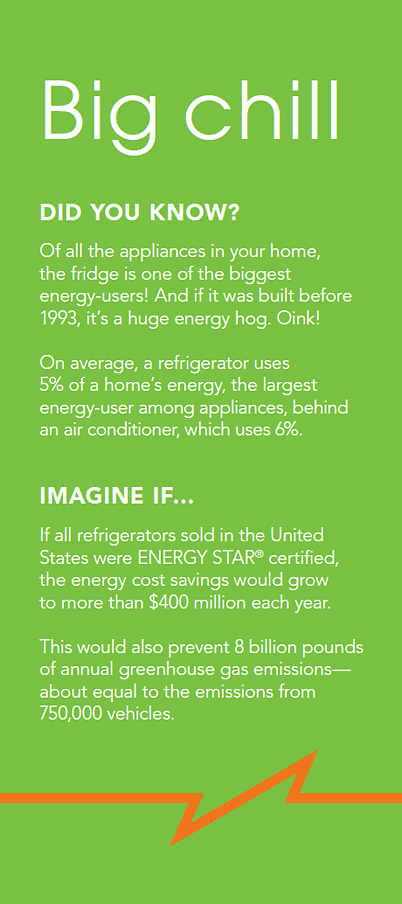Energy Efficiency: Kitchen
Use the navigation arrows or swipe (touchscreen) to view the displays for this area.
-

What's Cookin'?
Ah, the kitchen - the heart of the home, where family and friends gather, bellies are nourished, and appliances plug away.
Let's take a closer look and see how we can save energy, emissions, and more than a few pennies.
-

Refrigerator
Big Chill
Did you know?
Of all the appliances in your home, the fridge is one of the biggest energy-users! And if it was built before 1993, it's a huge energy hog. Oink!
On average, a refrigerator uses 5% of a home's energy, the largest energy-user among appliances, behind an air conditioner, which uses 6%.
Imagine if...
If all refrigerators sold in the United States were ENERGY STAR® certified, the energy cost savings would grow to more than $400 million each year.
This would also prevent 8 billion pounds of annual greenhouse gas emissions - about equal to the emissions from 750,000 vehicles.

Energy-saving tips:
- Keep the temperature set between 35 and 38 degrees.
- Try not to put the refrigerator near a heat source - an oven, dishwasher or even direct sunlight from a window - where it will have to work harder to maintain cool temperatures.
- Clean the coils of your fridge every six months to keep it running efficiently.
- Fill empty spaces inside with jugs of water to hold in the cold.
- Get rid of that older, energy-munching second refrigerator in your garage! It can cost you hundreds of dollars a year. One large refrigerator is cheaper to run than two smaller ones.

Buying ideas if you are shopping for a new fridge:
- Consider an ENERGY STAR® certified refrigerator, which is at least 10% more energy efficient than models that meet the federal minimum energy efficiency standard.
- Buy a refrigerator with a top-mounted freezer. A top-freezer refrigerator that has earned the ENERGY STAR uses less energy than a 60-watt light bulb.
- Skip the icemaker and dispenser. Through-the-door icemakers and water dispensers are convenient but increase a refrigerator's energy use by 14-20% and may raise the purchase price by $75 to $250.
-


Dishwasher
Wishy Washy
Ever wonder if it is greener to wash your dishes by hand?
Fear not, studies show that an automatic dishwasher uses about half the energy and one-sixth the water used by the average hand-washer. And if that isn't convincing enough, the automatic dishwasher uses less detergent and gets the dishes cleaner.
Did you know?
Dishwashers that have earned the ENERGY STAR® are, on average, 5% more energy efficient and 15% more water efficient than standard models.
This would also prevent 8 billion pounds of annual greenhouse gas emissions - about equal to the emissions from 750,000 vehicles.
Energy-saving tips:
Scrape, don't rinse.
Rinsing dishes can use up to 20 gallons of water before the dishes are even loaded. ENERGY STAR® certified dishwashers and today's detergents are designed to do the cleaning for you. If your dirty dishes sit overnight, use your dishwasher's rinse feature. It uses a fraction of the water used for hand rinsing.
Fill 'er up.
Dishwashers use the same amount of energy and water regardless of the number of dishes, so run full loads whenever possible.
Skip the heat.
Select the no-heat drying option. It gives good drying results with less energy.
Keep it light.
Most dishwashers have several settings. For everyday loads, the "light cycle" should do the trick instead of normal, heavy, or pots and pans cycles.
-

Oven/Stove
Hot off the range
Residential ovens, ranges, and stovetops generally aren't big energy consumers. In fact, they don't carry EnergyGuide labels or ENERGY STAR® recommendations.
However, there are still many strategies to save energy and money while baking your favorite chocolate cake or recipe.
Try not to peek.
Each time you open the oven door, the temperature drops by about 25 degrees. Instead, look through the window or use a timer.
Check the seal.
Now and then check the seal on your oven door for cracks or tears. Even a small gap can let heat escape.
To preheat or not to preheat...
Preheating is almost obsolete. Newer ovens heat up so quickly that you really only need to preheat when baking delicate cakes and dishes.
Convectionally speaking.
A convection oven uses a fan to jettison heated air around the food that is cooking, distributing the heat more evenly and quickly. As a result, convection ovens decrease cooking times and temperatures, reducing energy use by about 20%.
Heavy metal.
Did you know that using glass or ceramic pans instead of metal in the oven will allow you to turn the temperature down about 25°F and cook foods just as quickly?
Don't be foiled.
Try to refrain from lining oven racks with foil. It blocks heat flow and makes the oven work harder to cook food.
It's toasty in here.
Consider cooking smaller meals in a toaster or microwave. A toaster oven uses about half the energy of a conventional over, while a microwave uses about one third of the energy.
Gas or electric?
Residential ovens, ranges, and stovetops can be powered by either natural gas or electricity.
In general, electric ovens are less expensive to purchase, but since gas is typically less expensive than electricity, gas ovens usually cost less to operate.
-

Plugged In
Is a phantom lurking in your kitchen?
Many electronics draw a small amount of power even when turned off, called phantom load. By plugging small appliances into smart power strips, you can turn them all off at once and stop wasting energy. Or simply unplug your appliances when not in use.
-

Trash Talkin'
Whoa! Don't throw that away.
Did you know that the United States produces 70% of the world's solid waste? Yes, 70%! Yet, nearly 90% of what we throw away could be recovered through reuse, recycling or composting. What can we do to waste less? Reduce! Reuse! Recycle!
-

Ditch Disposables!
A big hurdle that people need to overcome is using things once and throwing them away (80% of U.S. products).
The skinny on single-use items:
-
Every three months, Americans throw enough aluminum in landfills to rebuild our nation's entire commercial air fleet.
Recycling just one can saves enough electricity to light a 25 watt CFL bulb for 14 hours.
-
Americans throw away enough office paper each year to build a 12-foot high wall from Seattle to New York.
Recycling paper cuts energy use by 60%, water use by 80% and air pollution by 95%.
-
More than 28 billion glass bottles and jars end up in landfills every year.
Recycling glass takes only 30% of the energy required to produce glass from raw materials.
-
Americans trash about 25 billion Styrofoam cups each year. This nasty material does not biodegrade. So 500 years from now, the polystyrene cup you toss out today will still exist.
Americans throw away 2.5 million plastic bottles every hour!
Plastic production accounts for 4% of the nation's energy usage.
Since most of us (86%) have access to curbside or drop-off paper recycling programs, it is hard to find an excuse not to recycle.
Consider the benefits:
- If we recycled all of the newspapers printed in the U.S. on a typical Sunday, we would save 550,000 trees - or about 26 million trees per year (California Department of Conservation).
- Making paper from recycled paper reduces the related contribution to air pollution 95%.
- Glass can be recycled and re-manufactured an infinite amount of times and never wear out. Making glass from recycled material cuts related water pollution by 50%. Recycling just one glass jar saves enough electricity to light an 11-watt CFL bulb for 20 hours.
-
-

The dirt on composting
Organic materials are a valuable resource, not waste. One way to divert waste is by composting.
Keeping food scraps, yard trimmings and grass out of the waste stream lowers disposal costs, returns valuable nutrients to the soil, and reduces the need for chemical fertilizers, which decreases non-point source pollution.
Be on the lookout for statewide food scrap recycling programs for commercial and institutional generators of organics, such as grocery stores, food processors, and universities. Also watch for manufacturing facilities to turn those organics into compost products, clean energy, animal feed, and liquid organic fertilizer.
Let's reach Connecticut's goal of recovering 58% of our municipal solid waste through waste reduction, reuse, recycling, and composting by 2024.

- Energy Efficiency: Kitchen
:
- What's Cookin'?
- Refrigerator
- Dishwasher
- Oven/Stove
- Plugged In
- Trash Talkin
- Ditch Disposables!
- The Dirt on Composting
- Energy is All Around Us »
- Energy Basics: What is Energy? »
- Energy Basics: Sources of Energy »
- Energy Basics: Energy Pathways »
- Energy Basics: Electricity generation, transmission and distribution »
- Energy Efficiency: Why is it Important? »
- Energy Efficiency: In Your Home »
- Energy Efficiency: Lighting »
- Energy Efficiency: Home Insulation »
- Energy Efficiency: Basement »
- Energy Assessment »
- Sustainable Business »
- Electricity in Connecticut »
- In Your Community »
